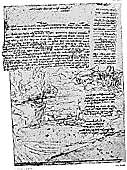

The most heavenly gifts seem to be showered on certain human beings. Sometimes supernaturally, marvelously, they all congregate in one individual. . . . This was seen and acknowledged by all men in the case of Leonardo da Vinci, who had. . . an indescribable grace in every effortless act and deed. His talent was so rare that he mastered any subject to which he turned his attention. . . . He might have been a scientist if he had not been so versatile.
 Leonardo's scientific and technical observations are found in his handwritten
manuscripts, of which over 4000 pages survive, including the one pictured
on the right, showing some rock formations (click on it to view an
enlargement). It seems that Leonardo
planned to publish them as a great encyclopedia of knowledge, but like many
of his projects, this one was never finished. The manuscripts are difficult
to read: not only did Leonardo write in mirror-image script from right to
left, but he used peculiar spellings and abbreviations, and his notes are
not arranged in any logical order. After his death his notes were scattered to
libraries and collections all over Europe.
While portions of Leonardo's technical
treatises on painting were published as early as 1651, the scope and caliber
of much of his scientific work remained unknown until the 19th century. Yet
his geological and paleontological observations and theories foreshadow many
later breakthroughs.
Leonardo's scientific and technical observations are found in his handwritten
manuscripts, of which over 4000 pages survive, including the one pictured
on the right, showing some rock formations (click on it to view an
enlargement). It seems that Leonardo
planned to publish them as a great encyclopedia of knowledge, but like many
of his projects, this one was never finished. The manuscripts are difficult
to read: not only did Leonardo write in mirror-image script from right to
left, but he used peculiar spellings and abbreviations, and his notes are
not arranged in any logical order. After his death his notes were scattered to
libraries and collections all over Europe.
While portions of Leonardo's technical
treatises on painting were published as early as 1651, the scope and caliber
of much of his scientific work remained unknown until the 19th century. Yet
his geological and paleontological observations and theories foreshadow many
later breakthroughs.
Leonardo knew well the rocks and fossils (mostly Cenozoic mollusks) found in his native north Italy. No doubt he had ample opportunity to observe them during his service as an engineer and artist at the court of Lodovico Sforza, Duke of Milan, from 1482 to 1499: Vasari wrote that "Leonardo was frequently occupied in the preparation of plans to remove mountains or to pierce them with tunnels from plain to plain." He made many observations on mountains and rivers, and he grasped the principle that rocks can be formed by deposition of sediments by water, while at the same time the rivers erode rocks and carry their sediments to the sea, in a continuous grand cycle. He wrote: "The stratified stones of the mountains are all layers of clay, deposited one above the other by the various floods of the rivers. . . In every concavity at the summit of the mountains we shall always find the divisions of strata in the rocks." Leonardo appear to have grasped the law of superposition, which would later be articulated fully by the Danish scientist Nicolaus Steno in 1669: in any sequence of sedimentary rocks, the oldest rocks are those at the base. He also appears to have noticed that distinct layers of rocks and fossils could be traced over long distances, and that these layers were formed at different times: ". . . the shells in Lombardy are at four levels, and thus it is everywhere, having been made at various times." Nearly three hundred years later, the rediscovery and elaboration of these principles would make possible modern stratigraphy and geological mapping.
In Leonardo's day there were several hypotheses of how it was that shells and other living creatures were found in rocks on the tops of mountans. Some believed the shells to have been carried there by the Biblical Flood; others thought that these shells had grown in the rocks. Leonardo had no patience with either hypothesis, and refuted both using his careful observations. Concerning the second hypothesis, he wrote that "such an opinion cannot exist in a brain of much reason; because here are the years of their growth, numbered on their shells, and there are large and small ones to be seen which could not have grown without food, and could not have fed without motion -- and here they could not move." There was every sign that these shells had once been living organisms. What about the Great Flood mentioned in the Bible? Leonardo doubted the existence of a single worldwide flood, noting that there would have been no place for the water to go when it receded. He also noted that "if the shells had been carried by the muddy deluge they would have been mixed up, and separated from each other amidst the mud, and not in regular steps and layers -- as we see them now in our time." He noted that rain falling on mountains rushed downhill, not uphill, and suggested that any Great Flood would have carried fossils away from the land, not towards it. He described sessile fossils such as oysters and corals, and considered it impossible that one flood could have carried them 300 miles inland, or that they could have crawled 300 miles in the forty days and nights of the Biblical flood.
How did those shells come to lie at the tops of mountains? Leonardo's answer was remarkably close to the modern one: fossils were once-living organisms that had been buried at a time before the mountains were raised: "it must be presumed that in those places there were sea coasts, where all the shells were thrown up, broken, and divided. . ." Where there is now land, there was once ocean. It was possible, Leonardo thought, that some fossils were buried by floods -- this idea probably came from his observations of the floods of the Arno River and other rivers of north Italy -- but these floods had been repeated, local catastrophes, not a single Great Flood. To Leonardo da Vinci, as to modern paleontologists, fossils indicated the history of the Earth, which extends far beyond human records. As Leonardo himself wrote:
Since things are much more ancient than letters, it is no marvel if, in our day, no records exist of these seas having covered so many countries. . . But sufficient for us is the testimony of things created in the salt waters, and found again in high mountains far from the seas.
